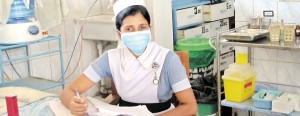News
Govt. inaction to blame for flu deaths, unions charge
View(s):With the influenza death toll rising by the day the health sector is blaming the government for doing little to combat the spread of the virus while authorities have other explanations for the figures. Last week the Epidemiology Unit (EU) recorded another eight deaths among patients, including a child, inflicted with the AH1N1 virus. This brings the total number of cases to 40 in the past six months. The victims include 10 pregnant women and five children under the age of 10 years.

A nurse at Vavuniya Hospital: Unions demand Health Ministry should provide masks to all doctors and nurses who treat the patients, or vaccinate the staff. Pic by Priyantha Hewage
The recent deaths were recorded from different parts of the island including Mulleriyawa, Kalutara, Welisara, Karapitiya, Vavuniya, Ratnapura, Colombo (Lady Ridgeway Hospital) and Jaffna. The nursing and the midwifery unions said the spiralling number of deaths was due to an alleged lack of preventative measures by the government.
They said insufficient education and awareness programmes had been conducted since H1N1 was identified in 2009.
The Epidemiology Unit, however, claims that H1N1 has lost its potential to cause a pandemic and has become a seasonal flu predominantly occurring in May, June and July.
The midwifery union, Samastha Lanka Suwa Sevaka Sangamaya, said since children belong to the vulnerable group it was important that awareness programmes be created among parents and children. The progammes needed to go further than simply telling people to wash hands and avoid public places, the union’s Secretary, Kusuma Dias, said, emphasising, “It is important to go from house to house carrying the message”.
She said the Health Ministry could use the midwives and the public health inspectors to educate the rural people. These personnel could visit schools and day care centres in rural areas and help to create awareness. “Even stage plays could be done to propagate the message,” she said.
All-Ceylon Nursing Union President Gamini Kumarasinghe said placing sole dependence on the print and electronic media to carry the message was wrong as it went unheard at grassroots level. “In the rural areas very few people read the newspapers or have the time or facility to watch the television,” Mr. Kumarasinghe said.
He stressed the importance of treating patients afflicted with the infectious virus in isolation to prevent other patients contracting the disease. “Separate wards must be established for such patients,” he said. Further, he said that the Health Ministry should provide masks to all doctors and nurses who treat the patients, or vaccinate the staff.
The Health Service Trade Union Alliance (HSTUA) said flu awareness programmes should include the distribution of handbills in crowded places and be carried out among children and parents at schools. HSTUA President Saman Ratnapriya said the Director-General of Health, Dr. Palitha Mahipala had agreed to follow up these recommendations.
With the season at its tail end, the Epidemiology Unit claims the virus is subsiding and there is no need for the masses to panic. It maintains that in the majority of cases the patients recover fully. The unit’s senior researcher, Dr. Athula Liyanapathirana, explained that the increase in the number of deaths reported was due to the delay in confirming that the deaths were due to the influenza virus. “The deaths have occurred several days ago but the test reports on these casualties are coming in only now,” he said.
Since deaths were taking place sporadically in different parts of the country there was a delay in obtaining laboratory diagnosis early. Dr. Liyanapathirana maintains that most deaths were due to patients having underlying medical problems and not seeking medical help immediately.
“There were cases of pulmonary embolism and back infection that showed up with the symptoms,” he said.As children, pregnant mothers, patients with chronic ailments and those above 65 years are vulnerable to AH1N1 infection they are requested to seek medical help early when its symptoms – fever, cough, running nose, headaches, muscle pain, diarrhoea and vomiting – show.
Dr. Liyanapathirana rejected health union claims that the Health Ministry had not acted to safeguard staff who care for infected patients, saying special masks used during invasive aerosol procedures had been provided to all hospitals through the Medical Officers of Health (MOH).
Detailed circulars and posters had been sent out to all hospitals together with posters regarding the infection control methods to be followed, he added. Health staff did not need special education as they only had to follow infection control methods using barrier nursing.
Dr. Liyanapathirana said the Health Ministry planned to send out public health midwives and public health inspectors from house to house to educate the public of infection control methods and the importance of seeking immediate treatment and was in contact with all 330 MOH in the country to implement the programme.

